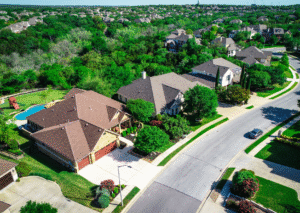What Are Multi-Family Real Estate Loans?
Multi-family real estate loans are financial products designed to help investors purchase or refinance properties that house multiple rental units under one roof—such as duplexes, triplexes, apartment buildings, and townhome complexes. These loans differ from traditional single-family home loans in terms of underwriting standards, loan limits, and the potential for income generation.
Multi-family loans are typically categorized into two main types:
- Residential multi-family loans (for 2-4 units), usually conforming to conventional mortgage guidelines
- Commercial multi-family loans (for 5+ units), which require more robust underwriting and are based more on property performance
These loans can be backed by traditional lenders (banks, credit unions), government-sponsored enterprises like Fannie Mae and Freddie Mac, or private lenders like No Limit Investments who specialize in real estate financing solutions tailored to investors’ needs.
Why Should Investors Consider Multi-Family Properties?
Investors often turn to multi-family real estate for its potential to generate consistent cash flow and long-term equity growth. Here’s why these properties are favored:
- Multiple income streams: With more than one unit, you reduce the risk of total vacancy.
- Easier to scale: Buying a 10-unit apartment complex is often more efficient than buying 10 separate homes.
- Tax benefits: Depreciation and operational deductions can offset income.
- Demand resilience: In economic downturns, multi-family rentals tend to maintain steady occupancy.
According to the National Multifamily Housing Council, over 44 million renter households in the U.S. live in multi-family units (NMHC 2023). This demand ensures that the asset class remains robust, making it a smart target for long-term wealth building.
How Do Multi-Family Real Estate Loans Differ from Single-Family Loans?
Understanding the key differences helps investors prepare better:
- Loan qualification: Lenders focus more on the property’s income-generating potential than just the borrower’s credit.
- Down payments: Multi-family loans typically require 20–30% down.
- Interest rates: Rates may be slightly higher than single-family mortgages due to perceived risk.
- Underwriting standards: Commercial multi-family loans involve analyzing net operating income (NOI), cap rate, and debt service coverage ratio (DSCR).
These differences may sound more complex, but with proper guidance and support such as through a platform like No Limit Investments, navigating them becomes much easier.
What Are the Most Common Types of Multi-Family Real Estate Loans?
Investors have several financing options depending on their goals:
- Conventional Loans – Available through banks and conform to Fannie Mae/Freddie Mac guidelines.
- FHA Multifamily Loans – Offered by HUD; great for affordable housing projects with low interest rates.
- Portfolio Loans – Held by lenders on their own books, offering flexible terms.
- Bridge Loans – Short-term financing to “bridge” the gap between purchase and permanent financing.
- DSCR Loans – Based on property income rather than personal income; ideal for investors with multiple properties.
- Hard Money Loans – Fast funding for distressed or time-sensitive deals, often used for fix-and-flip or rehab-to-rent strategies.
Specialized Services from No Limit Investments:
- Fix & Flip Loans
- Buy & Hold Mortgages
- BRRRR Financing (Buy, Rehab, Rent, Refinance, Repeat)
- Cash-Out Refinance
- Rate and Term Refinance
- New Construction Loans
- Short-Term Rental Loans
No Limit Investments provides flexible underwriting to help tailor financing to your real estate goals.
What Should Investors Know About Loan Qualification Requirements?
Each lender will have its own criteria, but general requirements include:
- Credit Score: Typically 620+ for conventional and 680+ for commercial loans
- Experience: Some lenders require prior landlord experience
- Property Income: Properties must meet DSCR thresholds (often 1.2+)
- Down Payment: Minimum 20% down for conventional; higher for commercial or portfolio loans
- Reserves: 6–12 months of reserves may be required
By partnering with a lender like No Limit Investments, investors gain access to personalized guidance and flexible options—even if they’re newer to the space.
How Can Multi-Family Loans Be Used to Scale a Portfolio?
One of the biggest advantages of multi-family loans is how effectively they support portfolio expansion:
- Leverage Equity: Use cash-out refinances to acquire more properties
- BRRRR Strategy: Buy, Rehab, Rent, Refinance, and Repeat to build wealth quickly
- Lower Risk per Door: Diversify rental income across units
- Easier Property Management: Managing 10 units in one building is simpler than 10 scattered houses
Strategic use of financing through No Limit Investments can help investors structure deals that snowball into large-scale portfolios.
What Risks Should Be Considered When Using Multi-Family Loans?
Despite the benefits, it’s important to consider potential pitfalls:
- Tenant turnover and vacancy
- Property management complexity
- Higher upfront costs and maintenance
- Market fluctuations and interest rate sensitivity
To mitigate these risks:
- Conduct thorough due diligence
- Keep reserves for vacancies and repairs
- Choose the right location with steady demand
- Work with experienced lenders and advisors
How Can Working with a Specialized Lender Make a Difference?
Not all lenders understand the unique dynamics of real estate investing. A specialized partner like No Limit Investments offers:
- Tailored solutions for investors at every experience level
- Faster funding for time-sensitive deals
- Flexible terms for unconventional properties
- Expertise in structuring deals for long-term scalability
Their team understands the needs of serious investors and provides services designed to help you grow with confidence.
What Is the Long-Term Wealth Potential of Multi-Family Real Estate?
Over time, multi-family real estate builds wealth in multiple ways:
- Appreciation: Properties increase in value
- Cash Flow: Monthly rent income supports lifestyle or reinvestment
- Tax Benefits: Deductions and depreciation reduce taxable income
- Equity Growth: As loans are paid down, equity builds
With proper planning, mentorship, and access to the right financing options, multi-family investments can fund retirement, build generational wealth, and create financial freedom.
Why Should You Start Building Wealth with Multi-Family Loans Today?

If you’re ready to take control of your financial future, now is the time to act. The real estate market continues to present opportunities—especially in multi-family housing.
Visit No Limit Investments to get started today. Whether you’re a first-time investor or looking to scale an existing portfolio, their flexible financing solutions, expert support, and investor-first mindset will help you succeed. Reach out today!
Final Thoughts
Multi-family real estate loans are one of the most powerful tools for building long-term wealth. They allow investors to scale efficiently, generate consistent income, and benefit from numerous tax and equity advantages. By understanding the loan options, qualification process, and strategic applications, anyone can begin—or accelerate—their journey toward financial independence. With a knowledgeable partner like No Limit Investments, you’re not just getting a loan—you’re gaining a strategic advantage.
Works Cited
National Multifamily Housing Council. “Quick Facts: Resident Demographics.” NMHC, 2023, www.nmhc.org/research-insight/quick-facts-figures/quick-facts-resident-demographics/. Accessed 6 Aug. 2025.
U.S. Department of Housing and Urban Development. “Multifamily Housing Programs.” HUD, www.hud.gov/program_offices/housing/mfh. Accessed 6 Aug. 2025.
Federal Housing Finance Agency. “Multifamily Mortgage Market Data.” FHFA, www.fhfa.gov/DataTools/Downloads/Pages/Multifamily.aspx. Accessed 6 Aug. 2025.
No Limit Investments. “Our Services.” No Limit Investments, 2025, www.nolimitinvestments.net/services/. Accessed 6 Aug. 2025.
Fannie Mae. “Multifamily Financing Solutions.” Fannie Mae, www.fanniemae.com/multifamily. Accessed 6 Aug. 2025.
Frequently Asked Questions
- What qualifies as a multi-family property for loan purposes?
A multi-family property typically includes two or more residential units in one structure. Properties with 2–4 units often qualify for residential multi-family loans, while those with 5 or more units fall under commercial multi-family loans. - How are multi-family real estate loans different from single-family loans?
Multi-family loans place greater emphasis on the income potential of the property rather than the borrower’s personal income. They often require higher down payments, different underwriting standards (such as DSCR), and may carry slightly higher interest rates. - What types of multi-family real estate loans are available to investors?
Investors can access various loan types, including conventional loans, FHA multifamily loans, portfolio loans, bridge loans, DSCR loans, and hard money loans. Lenders like No Limit Investments also offer tailored options such as BRRRR financing and short-term rental loans. - How can multi-family loans help scale a real estate portfolio?
These loans support scalable investing by allowing investors to finance multiple units under one loan, leverage equity through cash-out refinancing, and implement strategies like BRRRR to grow quickly while maintaining positive cash flow. - What are the risks of using multi-family real estate loans, and how can they be managed?
Key risks include tenant turnover, higher maintenance costs, and market fluctuations. Investors can mitigate these risks by conducting thorough due diligence, maintaining reserve funds, and partnering with experienced lenders like No Limit Investments for guidance and flexible solutions.







